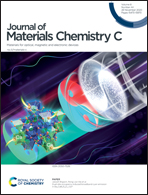Ladder-type bithiophene imide-based organic semiconductors: understanding charge transport mechanisms in organic field effect transistors†
Abstract
Here we have investigated the influence of the molecular length and structure of a series of BTI-based semiconductors on the stabilization of charged states in solution by in situ UV/Vis/NIR spectroelectrochemistry and in the solid state, at the active interface of operational OFET devices, by charge modulation spectroscopy (CMS). Interestingly, we found that charge stabilization in the shortest system of the series (BTI2) is strongly favored via a π-dimer formation which, in addition to higher thin film microstructural ordering, results in a greater electron mobility in organic field effect transistors (OFETs). The experimental results were interpreted using TD-DFT and DFT quantum chemical calculations at different levels of theory.



 Please wait while we load your content...
Please wait while we load your content...